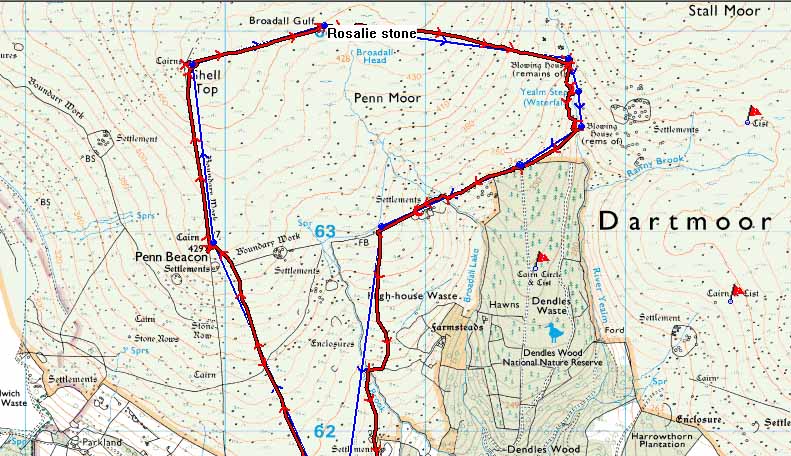|
F11 - Full screen F11 - Normal view Home & Contents |
|
"Alt" +
� |
At last, the first walk of 2008 .....
This walk: 2008-2-6 - East Rook Gate, boundary/leat, Penn Beacon, cairn, reave, Shell Top, Rosalie stone, River Yealm, blowing house, mould stone, Yealm Steps, second blowing house (across the river), Dendle's Waste, High House Waste. This walk is slightly modified after Walk 5 "Bronze Age, Medieval and More Recent Remains" in the Dartmoor Rescue Group "Walking in Southern Dartmoor" publication.
Walk details below - Information about the route etc.

East Rook Gate (photo actually taken at the end of the walk).

The end of the public path from the gate onto the moor.

View looking 'west' along the boundary / leat marked on the slope up to Penn Beacon (unfortunately, I did not 'fix' this location by GPS).

Penn Beacon, early view, showing the cairn and the trig point (triangulation pillar).

On the top of Penn Beacon (SX 59940 62940).

Looking north from Penn Beacon towards Shell Top, along the path and reave (an ancient boundary).

Penn Beacon cairn.

View from Penn Beacon to Cholwich Town China Clay Works, with Lee Moor China Clay Works behind.

Looking a little further north to Whitehill Yeo China Clay Works.

Whitehill Yeo China Clay Works.

A zoomed view from the photos above.

As previous photo.

Ditto

Penn Beacon cairn detail.

View north along the reave and path towards Shell Top.

View south along the reave and path back towards Penn Beacon (rays of flare/ sunlight from top left because this was looking almost into the sun).

Shell Top 'cairn' (on the map, or is it a minor tor?) at SX 59835 63833, with Plymouth Sound and the Plym estuary in the distance.

A first view of the Rosalie stone when approaching from the west.

The Rosalie stone, located at the head of the last gully before Broadall Head when approaching from the west.

The Rosalie stone, at SX 60507 64033 � 5 m ('fixed' by GPS).

General view from the route from the Rosalie stone towards the Yealm Valley, showing old settlements on the far hillside.

Zoomed view of settlement features from the previous photo.

River Yealm blowing house ('fixed' at SX 61719 63862 � 6 m) adjacent to almost-intertwined holly and rowan trees. It helps to use binoculars to spot the holly tree from high above the river as you approach from the west.

View of the scene from the northerly direction.

Closer view - the mould stone (see below) is on the ground, right of the wall, just this side of the 'long-ish' stone on the ground in the corner.

The mould stone, for casting molten tin into ingots for transport. There is said to be a second mould stone nearby, but I didn't find it.

View up the River Yealm from the bank beside the blowing house.

The top of Yealm Steps waterfall, 'fixed' by GPS at SX 61744 63694 � 6 m.

Looking down the Yealm Steps waterfall - this should look particularly good on the stereo page!

Looking back towards the blowing house, near the holly tree

Yealm Steps, from the west bank

A second blowing house just down stream of the Yealm Steps but across the river. A GPS 'fix' of this location gave SX 61762 63511 � 5 m (i.e. on 'this' side of the river).

A view over the wall showing the settlement/hut circles in High House Waste.

The lower gate for High House Waste (GPS fix SX 60728 62312 � 4 m). The notice notes that the land is owned by Dartmoor Preservation Association (see HERE specifically for High House Waste). Like many Dartmoor paths, it seems to 'double' as a stream after wet weather. Ford Brook is running left-to-right just out of the photo foreground.

Looking 'eastwards' across Dendles Wood National Nature Reserve to Harrowthorn Plantation.

Looking in a southerly direction towards (I believe) Butterdon Hill and Western Beacon. I didn't take bearings at the time - very remiss of me!

View down the lane to East Rook Gate, another area that 'doubles' as a stream after times of heavy rain.
MAP: Blue = planned route, Red = GPS track of the actual walk
The blue lines are the compass or GPS bearings. The red line is the route actually walked: it deviates from the blue lines sometimes so as to avoid obstacles such as thick bracken, gorse, bogs or clitter, and often to use paths or animal tracks that are not on the map.


Reproduced from Dartmoor OS Explorer map 1:25 000 scale by
permission of Ordnance Survey
on behalf of The Controller of Her Majesty's
Stationery Office.
© Crown copyright. All rights reserved. Licence number 100047373.
Also, Copyright © 2005, Memory-Map Europe, with permission
Access was via Cornwood, taking the road towards Torr. After leaving Cornwood, take the first road on the left, Rook Lane, followed shortly by a sharp right and then a left turn. Later, a bend right at East Rook followed by a left bend, then continue straight, ignoring a right turn to Hele Cross / South Hale. NOTE - these roads are as narrow as a road can be! There is only room for perhaps two/three cars to park comfortably on the verge at the end of the lane before you enter the stream and rough ground beyond.
Statistics
Distance - Memory Map track = 9.29 km / 5.8 miles
Start 9.30 am, Finish 1.50 pm, Duration 4 hr 20 min
Moving average 3.6 kph / 2.25 mph; Overall average 2.0 kph / 1.25 mph
All photographs on this web site are copyright ©2007-2016 Keith Ryan.
All rights reserved - please email for permissions
Dartmoor Tick Watch
The Cornish Pasty - The Compleat Pastypaedia
